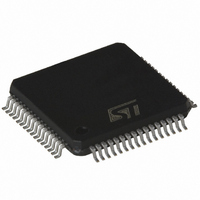E-STE100P STMicroelectronics, E-STE100P Datasheet - Page 16

E-STE100P
Manufacturer Part Number
E-STE100P
Description
IC TRANSCEIVER 3.3V 64 TQFP
Manufacturer
STMicroelectronics
Type
Transceiverr
Datasheet
1.E-STE100P.pdf
(31 pages)
Specifications of E-STE100P
Number Of Drivers/receivers
1/1
Protocol
MII
Voltage - Supply
3.15 V ~ 3.45 V
Mounting Type
Surface Mount
Package / Case
64-TQFP, 64-VQFP
Number Of Receivers
1
Data Rate
10/100Mbps
Operating Supply Voltage (typ)
3.3V
Package Type
TQFP
Operating Temperature Classification
Industrial
Operating Supply Voltage (max)
3.45V
Operating Supply Voltage (min)
3.15V
Mounting
Surface Mount
Pin Count
64
Operating Temperature (max)
85C
Operating Temperature (min)
-40C
Lead Free Status / RoHS Status
Lead free / RoHS Compliant
Other names
497-2143
STE100P
STE100P
Available stocks
Company
Part Number
Manufacturer
Quantity
Price
Company:
Part Number:
E-STE100P
Manufacturer:
STMicroelectronics
Quantity:
10 000
STE100P
7.2 100Base-TX Receive Operation
Regarding the 100Base-TX receiving operation, the device provides the receiving functions of PMD, PMA,
and PCS for receiving incoming data signals through category 5 UTP cable and an isolation transformer
with turns ratio of 1: 1. It includes the adaptive equalizer and baseline wander, data conversions of MLT3
to NRZI, NRZI to NRZ and serial to parallel, the PLL for clock and data recovery, the de-scrambler, and
the decoder of 5B/4B.
7.3 10Base-T Transmit Operation
This includes the parallel to serial converter, Manchester Encoder, Link test function, Jabber function and
the transmit wave-shaper and line driver described in the section of “Wave-Shaper and Media Signal Driv-
er” of “100BASE-T Transmission Operation”. It also provides Collision detection and SQE test for half du-
plex application.
7.4 10Base-T Receive Operation
This includes the carrier sense function, receiving filter, PLL for clock and data recovering, Manchester
decoder, and serial to parallel converter.
16/31
Data conversion of Parallel to Serial, NRZ to NRZI, NRZI to MLT3: After scrambled, the transmission
data with 5B type in 25MHz will be converted to serial bit stream in 125MHz by the parallel to serial func-
tion. After serialized, the transmission serial bit stream will be further converted from NRZ to NRZI format.
This NRZI conversion function can be bypassed, if the bit 7 of PR19 register is cleared as 0. After NRZI
converted, the NRZI bit stream is passed through MLT3 encoder to generate the TP-PMD specified MLT3
code. With this MLT3 code, it lowers the frequency and reduces the energy of the transmission signal in
the UTP cable and also makes the system easily to meet the FCC specification of EMI.
Wave-Shaper and Media Signal Driver: In order to reduce the energy of the harmonic frequency of trans-
mission signals, the device provides the wave-shaper prior to the line driver to smooth but keep symmetric
the rising/falling edge of transmission signals. The wave-shaped signals include the 100Base-TX and
10Base-T both are passed to the same media signal driver. This design can simplify the external magnetic
connection with single one.
Adaptive Equalizer and Baseline Wander: Since the high speed signals over the unshielded (or shield-
ed) twisted Pair cable will induce the amplitude attenuation and phase shifting. Furthermore, these effects
are depends on the signal frequency, cable type, cable length and the connectors of the cabling. So a re-
liable adaptive equalizer and baseline wander to compensate all the amplitude attenuation and phase shift-
ing are necessary. In the transceiver, it provides the robust circuits to perform these functions.
MLT3 to NRZI Decoder and PLL for Data Recovery: After receiving the proper MLT3 signals, the device
converts the MLT3 to NRZI code for further processing. After adaptive equalizer, baseline wander, and
MLT3 to NRZI decoder, the compensated signals with NRZI type in 125MHz are passed to the Phase Lock
Loop circuits to extract out the original data and synchronous clock.
Data Conversions of NRZI to NRZ and Serial to Parallel: After data is recovered, the signals will be
passed to the NRZI to NRZ converter to generate the 125 MHz serial bit stream. This serial bit stream will
be packed to parallel 5B type for further processing. The NRZI to NRZ conversion can be bypassed, if the
bit 7 of PR19 register is cleared as 0.
De-scrambling and Decoding of 5B/4B: The parallel 5B type data is passed to de-scrambler and 5B/4B
decoder to return their original MII nibble type data.
Carrier sensing: Carrier Sense(CRS) signal is asserted when the STE100P detects any 2 non-contiguous
zeros within any 10 bit boundary of the receiving bit stream. CRS is de-asserted when ESD code-group or
Idle code-group is detected. In half duplex mode, CRS is asserted during packet transmission or receive.
But in full duplex mode, CRS is asserted only during packet reception.













